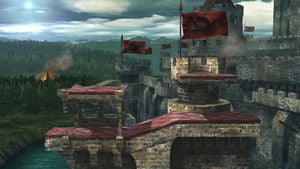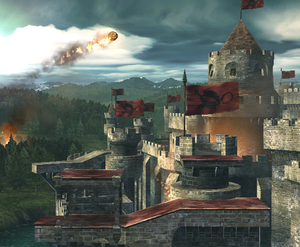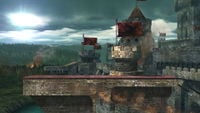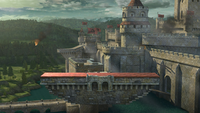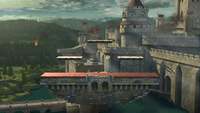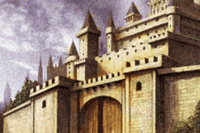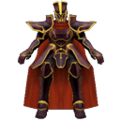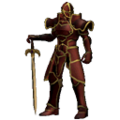Castle Siege: Difference between revisions
No edit summary |
m (→Trivia: The link lead to the character and not the location) |
||
| (44 intermediate revisions by 29 users not shown) | |||
| Line 1: | Line 1: | ||
{{ArticleIcons|fa=y|brawl=y|ssb4-u=y|ultimate=y}} | {{ArticleIcons|fa=y|brawl=y|ssb4-u=y|ultimate=y}} | ||
{{Infobox Stage | {{Infobox Stage | ||
| | |subtitle = ''[[Fire Emblem (universe)|Fire Emblem]]'' | ||
|name = Castle Siege | |name = Castle Siege | ||
|image = {{tabber|title1=Ultimate| | |image = {{tabber|title1=Ultimate|content1=[[File:SSBU-Castle Siege.png|300px]]|title2=Wii U|content2=[[File:SSB4UCastleSiege.jpg|300px]]|title3=Brawl|content3=[[File:Castle Siege Brawl.png|300px]]}} | ||
|caption = | |caption = [[File:FireEmblemSymbol.svg|50px|class=invert-dark]]<br>Castle Siege across the series. | ||
|universe = {{uv|Fire Emblem}} | |universe = {{uv|Fire Emblem}} | ||
|games = ''[[Brawl]]''<br>''[[SSB4]]'' ([[SSB4-U|Wii U]])<br>''[[Ultimate]]'' | |games = ''[[Brawl]]''<br>''[[SSB4]]'' ([[SSB4-U|Wii U]])<br>''[[Ultimate]]'' | ||
|availability = [[Starter stage|Starter]] | |availability = [[Starter stage|Starter]] | ||
|cratetype = Normal | |cratetype = Normal | ||
|maxplayers = 4 (''Brawl'')<br>[[8-Player Smash|8]] (Wii U and ''Ultimate'') | |maxplayers = 4 (''Brawl'')<br>[[8-Player Smash|8]] (Wii U and ''Ultimate'') | ||
|brawlmusic = ''{{SSBBMusicLink|Fire Emblem|Fire Emblem Theme}}''<br>''{{SSBBMusicLink|Fire Emblem|With Mila's Divine Protection (Celica Map 1)}}''<br>''{{SSBBMusicLink|Fire Emblem|Attack}}''<br>''{{SSBBMusicLink|Fire Emblem|Preparing to Advance}}''<br>'''''{{SSBBMusicLink|Fire Emblem|Winning Road - Roy's Hope}}'''''<br>'''''{{SSBBMusicLink|Fire Emblem|Shadow Dragon Medley}}'''''<br>'''''{{SSBBMusicLink|Fire Emblem|Ike's Theme}}'''''<br>''{{SSBBMusicLink|Fire Emblem|Against the Dark Knight}}''<br>''{{SSBBMusicLink|Fire Emblem|Crimean Army Sortie}}''<br>'''''{{SSBBMusicLink|Fire Emblem|Power-Hungry Fool}}'''''<br>'''''{{SSBBMusicLink|Fire Emblem|Victory is Near}}'''''<br>''{{SSBBMusicLink|Super Smash Bros.|Fire Emblem (Melee)}}'' | |brawlmusic = ''{{SSBBMusicLink|Fire Emblem|Fire Emblem Theme}}'' (100%)<br>''{{SSBBMusicLink|Fire Emblem|With Mila's Divine Protection (Celica Map 1)}}'' (20%)<br>''{{SSBBMusicLink|Fire Emblem|Attack}}'' (20%)<br>''{{SSBBMusicLink|Fire Emblem|Preparing to Advance}}'' (20%)<br>'''''{{SSBBMusicLink|Fire Emblem|Winning Road - Roy's Hope}}''''' (15%)<br>'''''{{SSBBMusicLink|Fire Emblem|Shadow Dragon Medley}}''''' (15%)<br>'''''{{SSBBMusicLink|Fire Emblem|Ike's Theme}}''''' (15%)<br>''{{SSBBMusicLink|Fire Emblem|Against the Dark Knight}}'' (10%)<br>''{{SSBBMusicLink|Fire Emblem|Crimean Army Sortie}}'' (10%)<br>'''''{{SSBBMusicLink|Fire Emblem|Power-Hungry Fool}}''''' (10%)<br>'''''{{SSBBMusicLink|Fire Emblem|Victory is Near}}''''' (10%)<br>''{{SSBBMusicLink|Super Smash Bros.|Fire Emblem (Melee)}}'' (10%) | ||
|forwiiumusic=''{{SSB4MusicLink|Fire Emblem|Fire Emblem Theme}}''<br>''{{SSB4MusicLink|Fire Emblem|Fire Emblem}}''<br>''{{SSB4MusicLink|Fire Emblem|Shadow Dragon Medley}}''<br>''{{SSB4MusicLink|Fire Emblem|With Mila's Divine Protection (Celica Map 1)}}''<br>'''''{{SSB4MusicLink|Fire Emblem|Winning Road - Roy's Hope}}'''''<br>''{{SSB4MusicLink|Fire Emblem|Attack (Fire Emblem)}}''<br>''{{SSB4MusicLink|Fire Emblem|Preparing to Advance}}''<br>''{{SSB4MusicLink|Fire Emblem|Crimean Army Sortie}}''<br>''{{SSB4MusicLink|Fire Emblem|Against the Dark Knight}}''<br>'''''{{SSB4MusicLink|Fire Emblem|Power-Hungry Fool}}'''''<br>''{{SSB4MusicLink|Fire Emblem|Victory Is Near}}''<br>'''''{{SSB4MusicLink|Fire Emblem|Ike's Theme}}'''''<br>''{{SSB4MusicLink|Fire Emblem|Lost in Thoughts All Alone (Remix)|Lost in Thoughts All Alone}}'' (DLC)<br>''{{SSB4MusicLink|Fire Emblem|Lost in Thoughts All Alone (Original)|Lost in Thoughts All Alone}}'' (DLC) | |forwiiumusic=''{{SSB4MusicLink|Fire Emblem|Fire Emblem Theme}}''<br>''{{SSB4MusicLink|Fire Emblem|Fire Emblem}}''<br>''{{SSB4MusicLink|Fire Emblem|Shadow Dragon Medley}}''<br>''{{SSB4MusicLink|Fire Emblem|With Mila's Divine Protection (Celica Map 1)}}''<br>'''''{{SSB4MusicLink|Fire Emblem|Winning Road - Roy's Hope}}'''''<br>''{{SSB4MusicLink|Fire Emblem|Attack (Fire Emblem)}}''<br>''{{SSB4MusicLink|Fire Emblem|Preparing to Advance}}''<br>''{{SSB4MusicLink|Fire Emblem|Crimean Army Sortie}}''<br>''{{SSB4MusicLink|Fire Emblem|Against the Dark Knight}}''<br>'''''{{SSB4MusicLink|Fire Emblem|Power-Hungry Fool}}'''''<br>''{{SSB4MusicLink|Fire Emblem|Victory Is Near}}''<br>'''''{{SSB4MusicLink|Fire Emblem|Ike's Theme}}'''''<br>''{{SSB4MusicLink|Fire Emblem|Lost in Thoughts All Alone (Remix)|Lost in Thoughts All Alone}}'' (DLC)<br>''{{SSB4MusicLink|Fire Emblem|Lost in Thoughts All Alone (Original)|Lost in Thoughts All Alone}}'' (DLC) | ||
|ultimatemusic=[[List of SSBU Music (Fire Emblem series)|''Fire Emblem'' series music]]<br>Main: ''{{SSBUMusicLink|Fire Emblem|Fire Emblem Theme}}''<br>Alternate: ''{{SSBUMusicLink|Fire Emblem|Story 5 Meeting}}'' | |ultimatemusic=[[List of SSBU Music (Fire Emblem series)|''Fire Emblem'' series music]]<br>Main: ''{{SSBUMusicLink|Fire Emblem|Fire Emblem Theme}}''<br>Alternate: ''{{SSBUMusicLink|Fire Emblem|Story 5 Meeting}}'' | ||
| Line 21: | Line 20: | ||
|ultimatedoubles= Counterpick/Banned | |ultimatedoubles= Counterpick/Banned | ||
}} | }} | ||
'''Castle Siege''' ({{ja|攻城戦|Kōjōsen}}, ''Castle Siege'') is a | '''Castle Siege''' ({{ja|攻城戦|Kōjōsen}}, ''Castle Siege'') is a {{uv|Fire Emblem}} stage in ''[[Super Smash Bros. Brawl]]'', {{forwiiu}} and ''[[Super Smash Bros. Ultimate]]''. It was first revealed for ''Brawl'' at [[E3]] 2006. It is based upon themes and motifs from the series as a whole, rather than one particular title, due to the stage not resembling any game of the series. The stage takes place at an unnamed castle, transitioning between the castle's roof, its throne room and an underground lava cavern. | ||
In ''Brawl'' and ''Ultimate'', Marth is fought here in his unlocking battle | In ''Brawl'' and ''Ultimate'', [[Marth]] is fought here in his unlocking battle and {{SSBU|Roy}} and {{SSBU|Robin}} are also fought here in their unlocking battles in the latter. | ||
==Stage overview== | ==Stage overview== | ||
| Line 34: | Line 33: | ||
After forty seconds in the underground cavern, the ground begins to rumble once more, as the stage transitions back to the first segment on the castle roof, and the cycle repeats. | After forty seconds in the underground cavern, the ground begins to rumble once more, as the stage transitions back to the first segment on the castle roof, and the cycle repeats. | ||
While the stage is transitioning between segments, it is a walk-off. This can have the effect of saving a character who would have been otherwise unable to recover, as the ground comes from beneath; for example, [[Bowser]] players attempting a stalled [[Flying Slam]] or [[Ganondorf]] players attempting a stalled aerial [[Flame Choke]]. However, players must make sure to move to the center of the stage if it is not transitioning to the throne room, as when the stage is done transitioning, players that are on the sides of the ground will fall rapidly with the ground, easily causing a [[self-destruct]]. | While the stage is transitioning between segments, it is a temporary walk-off. This can have the effect of saving a character who would have been otherwise unable to recover, as the ground comes from beneath; for example, [[Bowser]] players attempting a stalled [[Flying Slam]] or [[Ganondorf]] players attempting a stalled aerial [[Flame Choke]]. However, players must make sure to move to the center of the stage if it is not transitioning to the throne room, as when the stage is done transitioning, players that are on the sides of the ground will fall rapidly with the ground, easily causing a [[self-destruct]]. | ||
===Ω forms and Battlefield form=== | ===Ω forms and Battlefield form=== | ||
In ''Super Smash Bros. for Wii U'', the [[Ω form]] is set on a completely flat version of the first segment of the regular form, the castle roof. The stage does not transform. | In ''Super Smash Bros. for Wii U'', the [[Ω form]] is set on a completely flat version of the first segment of the regular form, the castle roof. The stage does not transform. | ||
In ''Super Smash Bros. Ultimate'', the Ω form and [[Battlefield form]] are set in the first segment of the normal form, and the main platform is similar in design to ''SSB4'''s Ω form; however, it does not extend below the [[blast line]], and it is resized and reshaped to match {{SSBU|Final Destination}} and {{SSBU|Battlefield}}, respectively. The three [[soft platform]]s of the Battlefield form bear the design seen on the platforms of the second segment, the throne room. | In ''Super Smash Bros. Ultimate'', the Ω form and [[Battlefield form]] are set in the first segment of the normal form, and the main platform is similar in design to ''SSB4''{{'}}s Ω form; however, it does not extend below the [[blast line]], and it is resized and reshaped to match {{SSBU|Final Destination}} and {{SSBU|Battlefield}}, respectively. The three [[soft platform]]s of the Battlefield form bear the design seen on the platforms of the second segment, the throne room. | ||
<gallery widths=200px> | <gallery widths=200px> | ||
SSB4UCastleSiegeOmega.jpg|[[Final Destination (SSB4)|Ω form]] in ''Super Smash Bros. for Wii U''. | SSB4UCastleSiegeOmega.jpg|[[Final Destination (SSB4)|Ω form]] in ''Super Smash Bros. for Wii U''. | ||
SSBU-Castle SiegeOmega.png|Ω form in ''Super Smash Bros. Ultimate''. | |||
SSBU-Castle SiegeBattlefield.png|Battlefield form in ''Super Smash Bros. Ultimate''. | |||
</gallery> | </gallery> | ||
| Line 50: | Line 49: | ||
==Origin== | ==Origin== | ||
[[File:CastleOstiaFE.png|thumb|left | [[File:CastleOstiaFE.png|thumb|left|Castle Ostia in ''Fire Emblem: The Blazing Blade'' is one of the castles where the large castle in the background of this stage is derived from.]] | ||
Throughout the {{uv|Fire Emblem}} series, the main objective for many chapters is to seize a castle, which is the inspiration for the theme of this stage. The ''Fire Emblem'' games typically depict castles as immense fortresses surrounded by woodlands, which provide extra defense for surrounding units. The first segment of this stage depicts one of these castles, where attacks are being launched from a forest in the background. | Throughout the {{uv|Fire Emblem}} series, the main objective for many chapters is to seize a castle, which is the inspiration for the theme of this stage. The ''Fire Emblem'' games typically depict castles as immense fortresses surrounded by woodlands, which provide extra defense for surrounding units. The first segment of this stage depicts one of these castles, where attacks are being launched from a forest in the background. | ||
| Line 57: | Line 56: | ||
In various ''Fire Emblem'' games, {{s|fireemblemwiki|Ballista}} appear as ranged weapons. Specific varieties known as {{s|fireemblemwiki|Hoistflamme}} and {{s|fireemblemwiki|Pachyderm}} are used by a class known as {{s|fireemblemwiki|Ballistician}}s in ''{{s|fireemblemwiki|Fire Emblem: Shadow Dragon and the Blade of Light}}'', ''{{s|fireemblemwiki|Fire Emblem: Mystery of the Emblem}}'', and ''Fire Emblem: Shadow Dragon''. These projectile weapons launch flaming or explosive missiles at their targets. The weapons in the background of the stage are presumably similar, but are described as catapults, and are launching fireballs rather than explosives. | In various ''Fire Emblem'' games, {{s|fireemblemwiki|Ballista}} appear as ranged weapons. Specific varieties known as {{s|fireemblemwiki|Hoistflamme}} and {{s|fireemblemwiki|Pachyderm}} are used by a class known as {{s|fireemblemwiki|Ballistician}}s in ''{{s|fireemblemwiki|Fire Emblem: Shadow Dragon and the Blade of Light}}'', ''{{s|fireemblemwiki|Fire Emblem: Mystery of the Emblem}}'', and ''Fire Emblem: Shadow Dragon''. These projectile weapons launch flaming or explosive missiles at their targets. The weapons in the background of the stage are presumably similar, but are described as catapults, and are launching fireballs rather than explosives. | ||
The second segment of the stage resembles a throne room; many major chapters in the ''Fire Emblem'' series involving seizing a throne from a powerful boss, such as a {{s|fireemblemwiki|General}}. In the background of the indoor area, a General can be seen sitting on a throne | The second segment of the stage resembles a throne room; many major chapters in the ''Fire Emblem'' series involving seizing a throne from a powerful boss, such as a {{s|fireemblemwiki|General}}. In the background of the indoor area, a General can be seen sitting on a throne; the ''Brawl'' and {{forwiiu}} versions bear a resemblance to the [[Black Knight]] from ''Fire Emblem: Path of Radiance'' and ''{{s|fireemblemwiki|Fire Emblem: Radiant Dawn}}'', while the ''Ultimate'' version wears more distinct red armor. Other {{s|fireemblemwiki|soldier}}s with red armor also appear throughout the indoor area; the opposing armies in ''Fire Emblem'' games traditionally wear red. These soldiers wear full body armor and wield swords, similar to that of enemy {{s|fireemblemwiki|Armor Sword}} units in ''Radiant Dawn''. | ||
{{s|fireemblemwiki|Armor Sword}} units in ''Radiant Dawn''. | |||
The collapsing statues that appear in the throne room may have been inspired by the destructible terrain in various other ''Fire Emblem'' games, specifically being introduced in ''{{s|fireemblemwiki|Fire Emblem: The Binding Blade}}''. ''The Binding Blade'' also introduced stages that take place in underground areas surrounded by magma, which have become a recurring theme throughout the series. The final segment of Castle Siege is designed to represent one of these areas. | The collapsing statues that appear in the throne room may have been inspired by the destructible terrain in various other ''Fire Emblem'' games, specifically being introduced in ''{{s|fireemblemwiki|Fire Emblem: The Binding Blade}}''. ''The Binding Blade'' also introduced stages that take place in underground areas surrounded by magma, which have become a recurring theme throughout the series. The final segment of Castle Siege is designed to represent one of these areas. | ||
| Line 70: | Line 68: | ||
===In ''Ultimate''=== | ===In ''Ultimate''=== | ||
With the introduction of the [[stage hazard]] toggle, Castle Siege doesn't transition past the first segment. Because of this, it was proposed as a legal stage during the earlier phases of the ''Ultimate'' metagame. However, it quickly proved to be controversial due to its asymmetrical layout and small size, as well as the slanted floor giving a disadvantage to projectile-focused characters, and the camera on the bottom right sometimes obstructing the view and hindering recovery and edgeguarding attempts. The stage was legal early on at tournaments such as {{ | With the introduction of the [[stage hazard]] toggle, Castle Siege doesn't transition past the first segment. Because of this, it was proposed as a legal stage during the earlier phases of the ''Ultimate'' metagame. However, it quickly proved to be controversial due to its asymmetrical layout and small size, as well as the slanted floor giving a disadvantage to projectile-focused characters, and the camera on the bottom right sometimes obstructing the view and hindering recovery and edgeguarding attempts. The stage was legal early on at tournaments such as {{Trn|GENESIS 6}}, but it quickly fell out of favour with it being one of the least played stages in the tournaments where it is legal. | ||
==Gallery== | ==Gallery== | ||
| Line 76: | Line 74: | ||
<gallery> | <gallery> | ||
Castle Siege Brawl.png|Castle Siege in ''Brawl''. | Castle Siege Brawl.png|Castle Siege in ''Brawl''. | ||
CastleSiege-ZoomOutView-Castle Top.jpg| | CastleSiege-ZoomOutView-Castle Top.jpg|An entire view of the castle. The stage itself is on the lower right. | ||
Inner-Castle-Siege.jpg|A view of the castle's moat and entrance. | Inner-Castle-Siege.jpg|A view of the castle's moat and entrance. | ||
Castle Siege Brawl outside.png|{{SSBB|Yoshi}}, {{SSBB|Donkey Kong}}, {{SSBB|Ike}} and {{SSBB|Zero Suit Samus}} fight on the top tier. | Castle Siege Brawl outside.png|{{SSBB|Yoshi}}, {{SSBB|Donkey Kong}}, {{SSBB|Ike}} and {{SSBB|Zero Suit Samus}} fight on the top tier. | ||
| Line 98: | Line 96: | ||
===''Super Smash Bros. Ultimate''=== | ===''Super Smash Bros. Ultimate''=== | ||
<gallery> | <gallery> | ||
Fire Emblem Heroes Smash.png|''Fire Emblem Heroes''-styled illustration from the [[Smash Bros. Countdown]]. | |||
SSBUWebsite23.jpg|{{SSBU|Bayonetta}} using [[Heel Slide#After-Burner Kick|After-Burner Kick]] on the stage. | SSBUWebsite23.jpg|{{SSBU|Bayonetta}} using [[Heel Slide#After-Burner Kick|After-Burner Kick]] on the stage. | ||
SSBUWebsiteYoungLink2.jpg|{{SSBU|Young Link}} tossing a [[Bomb (Link)|bomb]] at {{SSBU|Wario}} on the third segment of the stage. | SSBUWebsiteYoungLink2.jpg|{{SSBU|Young Link}} tossing a [[Bomb (Link)|bomb]] at {{SSBU|Wario}} on the third segment of the stage. | ||
SSBUWebsiteIke2.jpg|{{SSBU|Ike}} [[crouching]] on Castle Siege. | |||
SSBUWebsiteLucina4.jpg|{{SSBU|Marth}} and {{SSBU|Lucina}} [[taunting]] on Castle Siege. | |||
</gallery> | </gallery> | ||
==Names in other languages== | |||
{{langtable | |||
|ja={{ja|攻城戦|Kōjōsen}} | |||
|jaM=Castle Siege | |||
|en=Castle Siege | |||
|fr=Château assiégé | |||
|frM=Besieged Castle | |||
|es=Castillo asediado | |||
|esM=Besieged Castle | |||
|de=Die belagerte Burg | |||
|deM=The Besieged Castle | |||
|it=Il castello assediato | |||
|itM=The Besieged Castle | |||
|nl=Belaagde Burcht | |||
|nlM=Besieged Castle | |||
|ru={{rollover|Осада замка|Osada zamka|?}} | |||
|ruM=Castle Siege | |||
|ko={{rollover|공성전|Gongseongjeon|?}} | |||
|koM=Siege | |||
|zh_cn={{rollover|攻城战|Gōngchéngzhàn|?}} | |||
|zh_cnM=Siege | |||
|zh_tw={{rollover|攻城戰|Gōngchéngzhàn|?}} | |||
|zh_twM=Siege | |||
|pt=Cerco ao Castelo | |||
|ptM=Castle Siege | |||
}} | |||
==Trivia== | ==Trivia== | ||
*[[Pokémon Trainer]] stands in the little parapet on the right when he's on the first scene of the stage; if there are 3 or 4 Pokémon Trainers, 2 will stand in the parapet on the right, while the others will stand in the smaller parapet in the background. | *[[Pokémon Trainer]] stands in the little parapet on the right when he's on the first scene of the stage; if there are 3 or 4 Pokémon Trainers, 2 will stand in the parapet on the right, while the others will stand in the smaller parapet in the background. | ||
*In ''Brawl'', pausing the game while the stage is going through a transition will allow the transition to end more quickly, since the game continues to load the stage while the game is paused. When viewing a replay of a match with such a pause, the game will slow down during the transition to accommodate for the lost time. A similar effect happens with special moves that involve character-switching. This was fixed in ''Smash 4'' by having all segments of the stage loaded at once. | *In ''Brawl'', pausing the game while the stage is going through a transition will allow the transition to end more quickly, since the game continues to load the stage while the game is paused. When viewing a replay of a match with such a pause, the game will slow down during the transition to accommodate for the lost time. A similar effect happens with special moves that involve character-switching. This was fixed in ''Smash 4'' by having all segments of the stage loaded at once. | ||
*If a match on Castle Siege goes into [[Sudden Death]], it will begin on whichever segment the match ended on instead of always starting on the first section. This is likely done so the game doesn't have to reload the top level before Sudden Death. | |||
*If a match on Castle Siege goes into [[Sudden Death]], it will begin on whichever segment the match ended on | |||
*In ''Smash 4'', there is a visual bug on the regular form of this stage: once the stage has transitioned, the sun in the background of the first scene no longer has its blue glow during subseqent visits, for the rest of the match. | *In ''Smash 4'', there is a visual bug on the regular form of this stage: once the stage has transitioned, the sun in the background of the first scene no longer has its blue glow during subseqent visits, for the rest of the match. | ||
*In ''Ultimate'', the following [[Assist Trophy|Assist Trophies]] can only appear on the Battlefield and Omega forms of this stage: [[Burrowing Snagret]], [[Color TV-Game 15]], [[Devil]], [[Dr. Kawashima]], the [[Squid Sisters]], and [[Knuckles]]. The [[Moon]], [[Andross]], and [[Nikki]] cannot be summoned on this stage at all, likely due to some of the dark backgrounds. | |||
*In the ''Fire Emblem Heroes''-styled illustration from the [[Smash Bros. Countdown]] depicting Castle Siege, the original flag emblem in the background is replaced with the emblem of the {{s|fireemblemwiki|Askran Kingdom}}. | |||
==External links== | ==External links== | ||
| Line 118: | Line 147: | ||
{{SSBUStages}} | {{SSBUStages}} | ||
{{Fire Emblem universe}} | {{Fire Emblem universe}} | ||
[[Category:Stages]] | [[Category:Stages]] | ||
[[Category:Stages (SSB4-Wii U)]] | [[Category:Stages (SSB4-Wii U)]] | ||
[[Category:Past stages]] | [[Category:Past stages]] | ||
[[ | [[es:Castillo asediado]] | ||
Latest revision as of 15:09, July 18, 2024
| Fire Emblem Castle Siege | |
|---|---|
 Castle Siege across the series. | |
| Universe | Fire Emblem |
| Appears in | Brawl SSB4 (Wii U) Ultimate |
| Availability | Starter |
| Crate type | Normal |
| Maximum players | 4 (Brawl) 8 (Wii U and Ultimate) |
Castle Siege (攻城戦, Castle Siege) is a Fire Emblem stage in Super Smash Bros. Brawl, Super Smash Bros. for Wii U and Super Smash Bros. Ultimate. It was first revealed for Brawl at E3 2006. It is based upon themes and motifs from the series as a whole, rather than one particular title, due to the stage not resembling any game of the series. The stage takes place at an unnamed castle, transitioning between the castle's roof, its throne room and an underground lava cavern.
In Brawl and Ultimate, Marth is fought here in his unlocking battle and Roy and Robin are also fought here in their unlocking battles in the latter.
Stage overview[edit]
The match begins on a small section of the roof of the castle, which has two elevated platforms. The castle itself is being bombarded with catapulted fireballs, but these do not affect the match.
After forty seconds, the ground begins to rumble, and the stage transitions into the throne room of the castle. It is a walk-off, as the floor reaches both of the lateral blast lines. There are four platforms, two of which are supported by statues. These statues can be attacked, and each one will break if it takes enough damage, which destroys the platform it is supporting. In Brawl and Smash 4, these statues can be hit by projectiles, potentially blocking their travel, but in Ultimate, the statues are intangible to indirect attacks.
After forty seconds in the throne room, the ground begins rumbling again, and the stage transitions to an underground cavern. It consists of a single large stone platform which balances on a stone spire, tilting in both directions.
After forty seconds in the underground cavern, the ground begins to rumble once more, as the stage transitions back to the first segment on the castle roof, and the cycle repeats.
While the stage is transitioning between segments, it is a temporary walk-off. This can have the effect of saving a character who would have been otherwise unable to recover, as the ground comes from beneath; for example, Bowser players attempting a stalled Flying Slam or Ganondorf players attempting a stalled aerial Flame Choke. However, players must make sure to move to the center of the stage if it is not transitioning to the throne room, as when the stage is done transitioning, players that are on the sides of the ground will fall rapidly with the ground, easily causing a self-destruct.
Ω forms and Battlefield form[edit]
In Super Smash Bros. for Wii U, the Ω form is set on a completely flat version of the first segment of the regular form, the castle roof. The stage does not transform.
In Super Smash Bros. Ultimate, the Ω form and Battlefield form are set in the first segment of the normal form, and the main platform is similar in design to SSB4's Ω form; however, it does not extend below the blast line, and it is resized and reshaped to match Final Destination and Battlefield, respectively. The three soft platforms of the Battlefield form bear the design seen on the platforms of the second segment, the throne room.
Ω form in Super Smash Bros. for Wii U.
Hazards Off[edit]
With hazards off in Ultimate, the stage never transitions and remains in the first form atop the castle.
Origin[edit]
Throughout the Fire Emblem series, the main objective for many chapters is to seize a castle, which is the inspiration for the theme of this stage. The Fire Emblem games typically depict castles as immense fortresses surrounded by woodlands, which provide extra defense for surrounding units. The first segment of this stage depicts one of these castles, where attacks are being launched from a forest in the background.
A common motif throughout the Fire Emblem series is that many of the villains belong to a draconian race, or use dragons and wyverns in battle. The flags in this stage depict a dragon; while not identical to any particular flag in the series, it bears similarities to the flags of Daein and Dolhr, the main antagonistic nations in Fire Emblem: Path of Radiance and Fire Emblem: Shadow Dragon, respectively.
In various Fire Emblem games, Ballista appear as ranged weapons. Specific varieties known as Hoistflamme and Pachyderm are used by a class known as Ballisticians in Fire Emblem: Shadow Dragon and the Blade of Light, Fire Emblem: Mystery of the Emblem, and Fire Emblem: Shadow Dragon. These projectile weapons launch flaming or explosive missiles at their targets. The weapons in the background of the stage are presumably similar, but are described as catapults, and are launching fireballs rather than explosives.
The second segment of the stage resembles a throne room; many major chapters in the Fire Emblem series involving seizing a throne from a powerful boss, such as a General. In the background of the indoor area, a General can be seen sitting on a throne; the Brawl and Super Smash Bros. for Wii U versions bear a resemblance to the Black Knight from Fire Emblem: Path of Radiance and Fire Emblem: Radiant Dawn, while the Ultimate version wears more distinct red armor. Other soldiers with red armor also appear throughout the indoor area; the opposing armies in Fire Emblem games traditionally wear red. These soldiers wear full body armor and wield swords, similar to that of enemy Armor Sword units in Radiant Dawn.
The collapsing statues that appear in the throne room may have been inspired by the destructible terrain in various other Fire Emblem games, specifically being introduced in Fire Emblem: The Binding Blade. The Binding Blade also introduced stages that take place in underground areas surrounded by magma, which have become a recurring theme throughout the series. The final segment of Castle Siege is designed to represent one of these areas.
Tournament legality[edit]
In Brawl[edit]
This stage is generally a counterpick, but may be a starter in less restrictive rulesets. Though the stage has mostly unobtrusive hazards, the layout changes can give advantages or disadvantages to certain characters. In particular, the second segment has walk-off blast lines; these can allow easy or early KOs, especially for characters with chaingrabs, such as the Ice Climbers. The statues in the second segment also block projectiles, which can limit approach options for characters such as Falco or Pikachu.
In Smash 4[edit]
Castle Siege was formerly included in rulesets as a counterpick, due to chaingrabs being non-existent and therefore not being abusable on the walk-off edges on the second segment. However, the second segment still has issues with the statues (which block projectiles and increase hitlag), as well as an unusually high top blast line. Combined with the walk-offs, the stage is seen as unfairly beneficial to characters with poor recoveries, such as Little Mac; as a result, it was seen as too strong of a counterpick and has been banned in major rulesets since GENESIS 3.
In Ultimate[edit]
With the introduction of the stage hazard toggle, Castle Siege doesn't transition past the first segment. Because of this, it was proposed as a legal stage during the earlier phases of the Ultimate metagame. However, it quickly proved to be controversial due to its asymmetrical layout and small size, as well as the slanted floor giving a disadvantage to projectile-focused characters, and the camera on the bottom right sometimes obstructing the view and hindering recovery and edgeguarding attempts. The stage was legal early on at tournaments such as GENESIS 6, but it quickly fell out of favour with it being one of the least played stages in the tournaments where it is legal.
Gallery[edit]
Super Smash Bros. Brawl[edit]
Yoshi, Donkey Kong, Ike and Zero Suit Samus fight on the top tier.
Super Smash Bros. for Wii U[edit]
Castle Siege in Super Smash Bros. for Wii U.
Super Smash Bros. Ultimate[edit]
Fire Emblem Heroes-styled illustration from the Smash Bros. Countdown.
Bayonetta using After-Burner Kick on the stage.
Young Link tossing a bomb at Wario on the third segment of the stage.
Names in other languages[edit]
Trivia[edit]
- Pokémon Trainer stands in the little parapet on the right when he's on the first scene of the stage; if there are 3 or 4 Pokémon Trainers, 2 will stand in the parapet on the right, while the others will stand in the smaller parapet in the background.
- In Brawl, pausing the game while the stage is going through a transition will allow the transition to end more quickly, since the game continues to load the stage while the game is paused. When viewing a replay of a match with such a pause, the game will slow down during the transition to accommodate for the lost time. A similar effect happens with special moves that involve character-switching. This was fixed in Smash 4 by having all segments of the stage loaded at once.
- If a match on Castle Siege goes into Sudden Death, it will begin on whichever segment the match ended on instead of always starting on the first section. This is likely done so the game doesn't have to reload the top level before Sudden Death.
- In Smash 4, there is a visual bug on the regular form of this stage: once the stage has transitioned, the sun in the background of the first scene no longer has its blue glow during subseqent visits, for the rest of the match.
- In Ultimate, the following Assist Trophies can only appear on the Battlefield and Omega forms of this stage: Burrowing Snagret, Color TV-Game 15, Devil, Dr. Kawashima, the Squid Sisters, and Knuckles. The Moon, Andross, and Nikki cannot be summoned on this stage at all, likely due to some of the dark backgrounds.
- In the Fire Emblem Heroes-styled illustration from the Smash Bros. Countdown depicting Castle Siege, the original flag emblem in the background is replaced with the emblem of the Askran Kingdom.
External links[edit]
|
| |
|---|---|
| Fighters | Marth (SSBM · SSBB · SSB4 · SSBU) · Roy (SSBM · SSB4 · SSBU) · Ike (SSBB · SSB4 · SSBU) · Lucina (SSB4 · SSBU) · Robin (SSB4 · SSBU) · Corrin (SSB4 · SSBU) · Chrom (SSBU) · Byleth (SSBU) |
| Assist Trophies | Lyn · Black Knight · Tiki |
| Stages | Castle Siege · Arena Ferox · Coliseum · Garreg Mach Monastery |
| Item | Killing Edge |
| Other | Sothis |
| Trophies, Stickers and Spirits | Trophies (SSBM · SSBB · SSB4) · Stickers · Spirits |
| Music | Brawl · SSB4 · Ultimate |
| Masterpieces | Fire Emblem: Shadow Dragon and the Blade of Light · Fire Emblem: Mystery of the Emblem |

